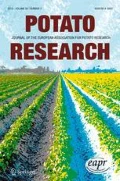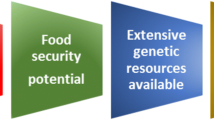Abstract
Potato tubers provide people not only with carbohydrates but also with other essential compounds for human health. Several investigations have compared the quality of crops grown under organic and conventional farming systems. The aim of the present study was to evaluate the concentrations of vitamins C, B1 and B2 as well as glycoalkaloids (α-solanine and α-chaconine) in potato tubers of different genotypes and to estimate the farming system (conventional and organic) impact on the content of these compounds. Twenty potato genotypes were grown under organic and conventional farming systems in Priekuli (Latvia) during 2010 and 2011. The concentrations of vitamins C, B1 and B2 as well as glycoalkaloids (α-solanine and α-chaconine) were significantly influenced by the potato genotype. The vitamin B1 concentration of potato genotypes grown in the organic field exceeded that of potato genotypes grown in the conventional field. A significant negative correlation was found between the vitamin C concentration and tuber yield only in the conventional field. No significant correlations were found between the other potato characteristics, such as starch content, tuber taste after boiling and glycoalkaloids, vitamins C, B1 and B2. The high broad-sense heritability for all tested traits (vitamin C 93%, vitamin B1 92%, α-solanine 88%, α-chaconine 84% and vitamin B2 70%) demonstrated that the high genetic diversity in the potato genotype population accounted for the phenotypic expression. The present study suggested that the breeding of new potato varieties with improved nutritional quality can be launched, and that the varieties that will be developed can be produced in an environmentally friendly way.
Similar content being viewed by others
References
Augustin J, Johnson SR, Teitzel C, True RH, Hogan JM, Toma RR, Shaw RL, Deutsch RM (1978) Changes in nutrient composition of potatoes during home preparation: II vitamins. Am Potato J 55:653–662
Brown CR (2005) Antioxidants in potato. Am J Potato Res 82:163–172
Brown CR, Haynes KG, Moore M, Pavek MJ, Hane DC, Love SL, Novy RG, Miller JC Jr (2010) Stability and broad-sense heritability of mineral content in potato: iron. Am J Potato Res 87:390–396
Brown CR, Haynes KG, Moore M, Pavek MJ, Hane DC, Love SL, Novy RG, Miller JC Jr (2011) Stability and broad-sense heritability of mineral content in potato: zinc. Am J Potato Res 88:238–244
Carbonaro M, Mattera M (2001) Polyphenoloxidase activity and polyphenol levels in organically and conventionally grown peach (Prunus persica L., cv. Regina bianca) and pear (Pyrus communis L., cv. Williams). Food Chem 72(4):419–424
Dale MFB, Mackay GR (2007) Inheritance of table and processing quality. In: Bradshaw JE and Mackay GR (ed) Potato genetics. CAB International, pp 285–263
Davies CS, Ottman MJ, Peloquin SJ (2002) Can germplasm resources be used to increase the ascorbic acid content of stored potatoes? Am J Potato Res V79:295–299
Everard J, Cobb E, Cobb A (1997) Effect of temperature on glycoalkaloid and chlorophyll accumulation in potatoes (Solanum tuberosum L. cv. King Edward) stored at low photon flux density, including preliminary modelling using an artificial neural network. J Agric Food Chem 45:1032–1038
Friedman M (2006) Potato glycoalkaloids and metabolites: roles in the plant and in the diet. J Agric Food Chem 54:8655–8681
Goyer A, Haynes KG (2011) Vitamin B1 content in potato: effect of genotype, tuber enlargement, and storage, and estimation of stability and broad-sense heritability. Am J Potato Res 88:374–385
Haase NU (2008) Healthy aspects of potatoes as part of human diet. Potato Res 51:239–258
Haase NU (2010) Glycoalkaloid concentration in potato tubers related to storage and consumer offering. Potato Res 53:297–307
Hanson WD (1963) Heritability. In: Hanson WD, Robinson HF (eds) Statistical genetics and plant breeding: a symposium and workshop sponsored by the Committee on Plant Breeding and Genetics of Agricultural Board at the North Carolina State College. Raleigh. NC. Publ. National Academy of Sciences – National Research Council, Washington, pp 125–140
Jadhav SJ, Sharma RB, Salunkhe DK (1981) Naturally occurring toxic alkaloids in foods. Crit Rev Toxicol 9:21–104
Kerlan MC, Ellissèche D (2000) Tuber quality: objectives in breeding and breeding research. Plant Breed Seed Sci 44(2):21–35
Koh E, Wimalasiri KMS et al (2008) A comparison of flavonoids, carotenoids and vitamin C in commercial organic and conventional marinara pasta sauce. J Sci Food Agric 88(2):344–354
Lairon D (2009) Nutritional quality and safety of organic food. A review. Agronomy for Sustainable Development. DOI: 10.1051/agro/2009019 www.agronomy–journal.org Accessed 16 October 2012
Lombardo S, Pandino G, Mauromicale G (2012) Nutritional and sensory characteristics of ‘early’ potato cultivars under organic and conventional cultivation systems. Food Chem 133:1249–1254
Love SL, Pavek JJ (2008) Positioning the potato as a primary food source of vitamin C. Am J Potato Res 85:277–285
Lu W, Yu M, Bai Y, Li W, Xu X (2012) Crude protein content in diploid hybrid potato clones of Solanum phyreja-S. stenotomum. Potato Res 55:315–322
Murniece I, Kampuse S, Kruma Z, Ungure E, Skrabule I, Bumane S, Vaivode A (2011a) The comparison of quality parameters of conventionally and organically grown potatoes. 7th International congress "Food technologists, biotechnologists and nutritionists": proceedings, Opatija, Croatia, 311–316
Murniece I, Karklina D, Galoburda R, Santare D, Skrabule I, Costa HS (2011b) Nutritional composition of freshly harvested and stored Latvian potato (Solanum tuberosum) varieties depending on traditional cooking methods. J Food Compos Anal 24:699–710
Murniece I, Kruma Z, Skrabule I (2012) Carotenoids and colour before and after storage of organizally and conventionally cultivated potato genotypes in Latvia. World Acad Sci Eng Tech 67:1201–1205
Said HM (2011) Intestinal absorption of water-soluble vitamins in health and disease. Biochem J 437(3):357–372
Savage GP, Searle BP, Hellenas KE (2000) Glycoalkaloid content, cooking quality and sensory evaluation of early introduction of potatoes into New Zealand. Potato Res 43:1–7
Skrabule I, Grauda D, Mikelsone A, Vasariete A (2010) Adaptation of glycoalkaloids detection method for evaluation of Latvian potato genetic resources. Agr Res 8(3):705–710
Skrabule I, Muceniece R, Kirhnere I, Nakurte I, Klavins K, Mekss P (2011) The detection of glycoalkaloid (α-solanine and α-chaconine) content in tubers of potato varieties, grown in organic and conventional farming systems. Abstracts of the 18th Triennial Conference of the European Association for Potato Research, Oulu, Finland, 138
Storey RMI, Davies HV (1992) Tuber quality. In: Harris P (ed) The potato crop. Chapman and Hall, London, pp 507–569
Van Gelder WMJ, Vinke JH, Scheffer JJC (1988) Steroidal glycoalkaloids in tubers and leaves of Solanum species used in potato breeding. Euphytica 147–158
Wszelaki AL, Jeannine F, Delwiche JF, Sonia D et al (2005) Sensory quality and mineral and glycoalkaloid concentrations in organically and conventionally grown redskin potatoes (Solanum tuberosum). J Sci Food Agric 85:720–726
Zhang L, Porter GA, Bushway RJ (1997) Ascorbic acid and glycoalkaloid content of Atlantic and superior potato tubers as affected by supplemental irrigation and soil amendments. Am Potato J 74:285–303
Zywickia B, Catchpolea G, Draperb J, Fiehna O (2005) Comparison of rapid liquid chromatography-electrospray ionisation-tandem mass spectrometry methods for determination of glycoalkaloids in transgenic weld-grown potatoes. Anal Biochem 336:178–186
Acknowledgments
This research was supported by the European Social Found co-financed project Nr. 2009/0218/1DP/1.1.1.2.0/09/APIA/VIAA/099. The data analysis was done in the framework of the National Research Programme NATRES project FOOD.
Author information
Authors and Affiliations
Corresponding author
Rights and permissions
About this article
Cite this article
Skrabule, I., Muceniece, R. & Kirhnere, I. Evaluation of Vitamins and Glycoalkaloids in Potato Genotypes Grown Under Organic and Conventional Farming Systems. Potato Res. 56, 259–276 (2013). https://doi.org/10.1007/s11540-013-9242-0
Received:
Accepted:
Published:
Issue Date:
DOI: https://doi.org/10.1007/s11540-013-9242-0




